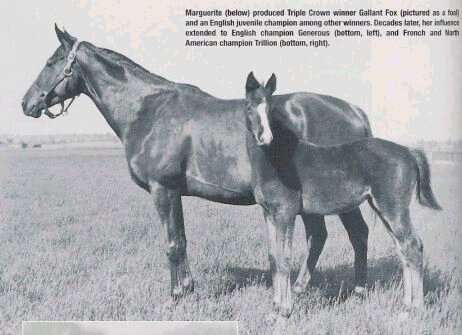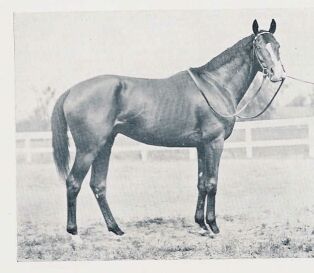

Gallant Fox was a big bay colt with a blaze, a watch eye, and four white coronets. He was bred and owned by William Woodward, Sr., the owner of Belair Stud, and was foaled at Bull Hancock's Claiborne Farm on March 23, 1927.
The Belair Stud had been founded during the eighteenth century by Samuel Ogle, a charter member of Maryland's Jockey Club. William Woodward inherited the property from his uncle, James T. Woodward, in 1910. A major breeder, William Woodward was part of the syndicate that paid $125,000 for *Sir Gallahad III and imported him into America. Standing at Claiborne, the high priced stallion topped the sire's list four times.
Woodward sent a number of mares to Sir Gallahad III in 1926, including his great broodmare Marguerite, who produced not only Gallant Fox, but also Petee-Wrack, winner of numerous stakes races including the Suburban Handicap, the Metropolitan Handicap, the Merchants and Citizens Handicap, and Travers Stakes; Fighting Fox, whose triumphs included the Massachusetts Handicap, the Wood Memorial, the Grant Union Hotel Stakes, and the Carter Handicap; Foxbrough, who was the Champion Two Year Old Colt in England in 1938; the stakes placed filly Lucky Pledge, and three stakes producing daughters.

Future Hall of Fame trainer Sunny Jim Fitzsimmons conditioned Gallant Fox, and discovered that the colt worked best in company. Sunny Jim often worked him using relays, since no other horse in the barn could match him throughout an entire work.
Racing fans of the 1930's dubbed Woodward's star 'The Fox of Belair', and rumor had it that the Fox won because any horse that drew up to him on the outside saw his wall eye and was too frightened to go past.

Gallant Fox made his first start on June 24, 1929, at Aqueduct. Still green, he ran third behind Desert Light in the five furlong allowance event. Five days later he ran out of the money for the only time, finishing eighth in the Tremont Stakes, having been far more interested in watching the activity around him than in breaking with the rest of the colts. When he noticed that the others were leaving, he did attempt to catch up, but passed only five of the thirteen starters.
Gallant Fox finally broke his maiden on July 29, with a length and a half victory over Caruso in the Flash Stakes. Caruso then beat him in the U.S. Hotel Stakes four days later.
In the Futurity Trial Gallant Fox was starting to improve. Despite traffic problems he closed fast, getting within a neck of the winner, Polygamous. In the Futurity, Gallant Fox met the season's star juvenile, Whichone, who one by three lengths while Gallant Fox battled it out in a three-way photo for second and ended up third by a nose.
The final start in his freshman campaign came in the Junior Champion Stakes at Aqueduct. He gave five pounds to Desert Light and beat him by two lengths with such authority that although it was Futurity Stakes winner Whichone who was named Champion Two Year Old Colt, Gallant Fox was considered to be one of the leading contenders for the spring classics.
That fit perfectly into William Woodward's plans. Two-year-old racing held little interest for the owner of Belair, who preferred to focus on his three-year-olds.
Earl Sande came out of retirement to become Gallant Fox's regular jockey in 1930, and the pair began the season with a four length win over Crack Brigade in the Wood Memorial Stakes, despite being boxed in on the far turn. The Preakness came before the Derby that year, and Gallant Fox performed with valor. Escaping from a pocket and recovering from loss of ground, Gallant Fox and Earl Sande began a brilliant drive that was described by the New York Times as:
"the most electrifying dash that has been seen in Maryland in many a day. Finding a hole here and a gap there, Sande snaked his way through the field and was third at the far turn."
The Fox of Belair caught Crack Brigade at the mile mark, and pulled away to triumph by three quarters of a length, going away.
That year's Kentucky Derby was the first in which a starting gate was used, and Gallant Fox was once again an easy winner, with Gallant Knight finishing second. Among those in attendance was the Seventeenth Earl of Derby, a guest of Joseph Widener. As Gallant Fox led the field into the stretch, Lord Derby turned to William Woodward and delivered the praise "Fine stuff," then headed for the winner's circle.

It was Earl Sande's third win in the Kentucky Derby, having ridden Zev in 1923 and Flying Ebony in 1925, and the victory made Sande the first jockey since Issac Murphy to ride three Kentucky Derby winners.
In the Belmont, Gallant Fox met the previous year's juvenile champion, Whichone, who had missed the first two classics with knee problems, but had returned to racing with an impressive victory in the Withers. When Earl Sande was involved in an automobile accident, the rider was not about to let his mount face the challenge presented by the Whitney champion without him, and Sande rode despite his injuries.
As a light drizzle fell on the historic New York racetrack, Gallant Fox ran wire to wire, easily holding off the favored Whichone, previously deemed invincible, as well as the top colt Questionnaire, to set a new stakes record and become America's second Triple Crown winner. Gallant Fox also replaced Zev as the all time leading money winner following the win.
The Fox of Belair loafed through an easy score in the Dwyer Stakes, then met more of a challenge in the Arlington Classic. He had to fight Gallant Knight through the stretch, winning by a neck.
This series of victories prompted writers to hail him as the "greatest horse since Man o' War." Comparing the two, Bryan Field wrote:
"Gallant Fox is a horse of individuality and magnetism, and thus far has behaved in the opposite manner to the tempestuous Man o' War, who was a devil to break and a big, raw colt to handle and train as a two-year-old. He gives the impression of unusual grace and distinction and his symmetry and harmony have attracted thousands of admirers, as did Man o' War's effervescent temperament."
In the meantime, Whichone had won the Ballot Handicap, the Saranac Handicap, and the Whitney Stakes. Gallant Fox and Whichone had a much anticipated third meeting in the Travers Stakes. The track came up muddy, but neither champion was scratched.
A speed dual developed almost immediately following the break. Sonny Workman, on Whichone, felt that the mud on the rail was deeper than it really was, and kept his horse in the middle of the racetrack. The Fox raced even farther from the rail, and when Whichone bore out in the turn, he carried Gallant Fox out with him. In the meantime, Jim Dandy had been saving ground on the rail, and the one hundred to one longshot slipped by to beat an exhausted Gallant Fox by eight lengths. Whichone's brilliant career was over, for he was injured at the top of the stretch and finished another six lengths back.
The Fox of Belair redeemed himself in the Saratoga Cup, loafing through the mile and three quarters in 2:56, a second slower than Reigh Count's stakes record. Then Gallant Fox met the outstanding colt Questionnaire, who had not been beaten since his third place finish in the Belmont Stakes, in the Lawrence Realization. Giving away three pounds to his challenger, Gallant Fox trailed Questionnaire into homestretch, and when he made his bid the other colt bore out, carrying him to the outer rail. The two straightened out and pounded down the stretch, eyeball to eyeball, and while Workman went to the whip on Questionnaire, Earl Sande abandoned his bat, hand riding the game Gallant Fox in the greatest battle of his career. The Fox of Belair prevailed in the end, winning by his red hooded head and earning Horse of the Year honors. After cantering to victory in the Jockey Club Gold Cup, Gallant Fox developed a fever, and was retired from racing, having earned a record $328,165.
As a sire, Gallant Fox stood at Claiborne Farm, and enjoyed great success, siring 1935 Triple Crown winner Omaha in his first crop. From the second group of foals sired by the Triple Crown winner came Flares, the full brother to Omaha who scored in the Ascot Gold Cup, as well as 1936 Horse of the Year Granville. William Woodward seemed to have great luck producing exceptional full siblings, for not only did Omaha and Flares exhibit rare talent, but Fighting Fox and Foxbrough, both full brothers to Gallant Fox, were consistent winners as well.
The Fox of Belair sired a total of twenty stakes winners before he passed away on November 13, 1954, and he is buried at Claiborne Farm near his sire, *Sir Gallahad III. Said the Blood-Horse:
"Since the retirement of Man o' War no horse has captured the imagination of the American public as has Gallant Fox. After a relatively light campaign as a two-year-old, he swept like a meteor across the racing sky of 1930 and when he was retired for all times after his bloodless triumph in the Jockey Club Gold Cup he was more than a racehorse -he was an institution."
| Year | Starts | Wins | Seconds | Thirds | Earnings |
|---|---|---|---|---|---|
| Lifetime | 17 | 11 | 3 | 2 | $328,165 |
| Sir Gallahad III | Teddy | Ajax | Flying Fox |
| Amie | |||
| Rondeau | Bay Ronald | ||
| Doremi | |||
| Plucky Liege | Spearmint | Carbine | |
| Maid of the Mint | |||
| Concertina | St. Simon | ||
| Comic Song | |||
| Marguerite | Celt | Commando | Domino |
| Emma C. | |||
| Maid of Erin | Amphion | ||
| Mavourneen | |||
| Fairy Ray | Radium | Bend Or | |
| Taia | |||
| Seraph | St. Frusquin | ||
| St. Marina |


This text protected by all applicable copyright laws. Do not duplicate or distribute without written permission. © Spiletta42.